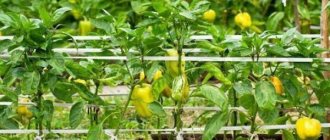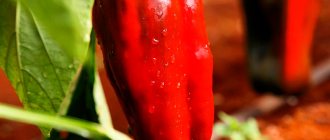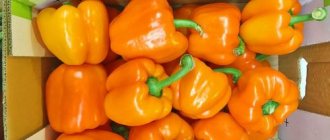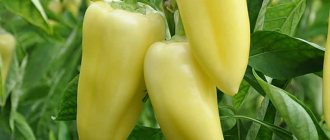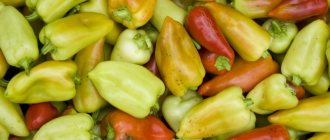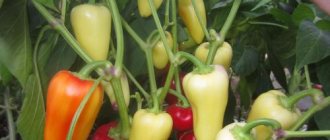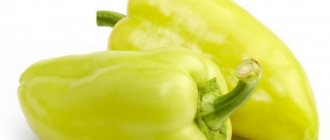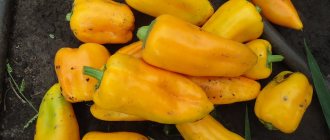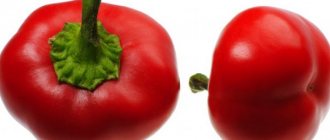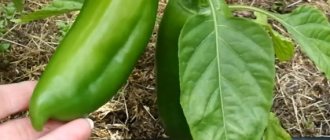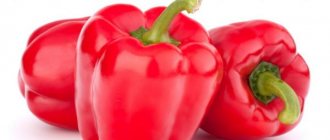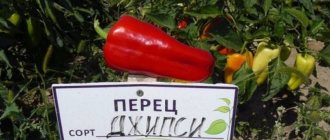Sweet peppers belong to the nightshade family. In its homeland it is a perennial, but in Russia it is grown as an annual crop. There are many varieties and hybrids of this vegetable of various colors and shapes. Choosing the best one among them is not an easy task. The time for sowing seedlings is just around the corner, so it’s time to decide. We advise you to pay attention to the Sweet Pepper variety Lastochka. The mere fact that gardeners are still planting it, although more than 50 years have passed since the variety was included in the State Register of Agricultural Achievements, speaks volumes.
Pepper Swallow, about which gardeners have only positive reviews, has not been lost among many recently bred varieties and occupies its rightful place. Let's take a closer look at this variety, and for this we will compose a detailed description and description of the Swallow pepper and accompany it with a photo.
Description of pepper Swallow
The sweet pepper variety Lastochka, described in the article, is recommended for cultivation throughout Russia with the exception of the Far North. In the middle zone, the Urals and Siberia, it is cultivated in greenhouse conditions. In the south it is grown mainly in open ground.
Pepper Swallow is a standard plant with semi-spreading shoots. Its height ranges from 45 cm in open ground to 65 cm in a greenhouse. The stem is quite powerful, dark green in color. However, during the period of active fruiting, the bushes need tying or supports. Often the branches fall to the ground under the weight of the fruit, and the peppers begin to rot.
The leaves are medium-sized, elliptical, with slightly wavy edges. The leaf plates are smooth and glossy. The color is dark green, with pronounced veins of a lighter green hue. It blooms with small white-pink or white-violet flowers, shaped like a bell.
Bell pepper Swallow produces elongated cone-shaped fruits with a rounded nose. They are distinguished by moderate ribbing and are sometimes somewhat curved. Most often, the cause of slight curvature is the small height of the plant during the formation of large fruits. The length of the pods is 8-10 cm, their diameter reaches 4-6 cm. The average weight is 60-90 grams.
The skin of the Swallow pepper variety is smooth and thin. During the period of technical maturity, it is of a bright light green color. As the fruits ripen, they turn brown. At the stage of biological maturity they acquire a rich red hue.
Pepper Swallow is a thick-walled variety. The wall thickness ranges from 5 to 7 mm. It largely depends on the time of harvest. The fruits themselves form 3-4 sections with a small number of seeds.
According to reviews from vegetable growers, the Lastochka pepper variety has excellent taste characteristics both at the stage of full ripening and at the moment of technical maturity. The walls of the fruit are fleshy, juicy with a bright peppery taste and aroma.
Advantages and disadvantages of the variety
The Lastochka variety is valued by summer residents for the following positive characteristics:
- early ripeness;
- large fruit;
- good seed germination;
- excellent taste;
- friendly return of ripened tomatoes;
- resistance to wilting;
- good yield;
- rich vitamin composition;
- versatility of use.
The fruits of the plant can be eaten not only during the period of biological ripeness (red), but also during technical ripening (green).
Characteristics of pepper Swallow
According to the characteristics and description of the Swallow pepper variety, it is not resistant to low temperatures. Cooling down to 13 degrees Celsius causes plant development to stop. At subzero temperatures, seedlings die. That is why you should not rush to plant seedlings in a permanent place. And when transplanting peppers to open ridges, you need to provide temporary shelter made of film or agrofibre.
Attention!
The Swallow variety does not like moisture deficiency. As a rule, it reacts by dropping flowers and formed ovaries. However, waterlogging also has a negative effect on the crop. It stops absorbing nitrogen compounds. The formation of new shoots slows down, the leaves become small and lose their rich color.
The Lastochka variety is distinguished by medium-early ripening. The first fruits can be tasted already in the first half of July or 115-120 days after emergence. The varieties First Swallow and Golden Swallow ripen 7-10 days earlier.
Diseases and pests of the variety
At the seedling stage, Swallow may get blackleg. In most cases, the disease develops when the soil is over-moistened.
The variety is resistant to bacterial and verticillium wilt. If crop rotation is disrupted, the Swallow pepper may develop late blight.
The plant is sometimes attacked by pests such as spider mites, aphids, slugs, wireworms and beetles.
Prevention of late blight is carried out using the drugs Fitosporin or Bordeaux mixture. Decoctions of onion peels, wormwood and tobacco are used against pests that attack the stem of seedlings. The fight against wireworms and beetles, which destroy the root part of peppers, is carried out manually, after first laying out bait in the form of potatoes for the pest.
Landing rules
Pepper Swallow in the middle zone is grown mainly by seedlings. Only in the southern regions of Russia is sowing available directly into the ground.
Planting seedlings
Swallow pepper seeds are sown in the first ten days of March. This is the optimal time for sowing early ripening varieties. By mid-May, the plants are about 45-50 days old. Such seedlings take root best in a new place.
To sow seeds you will need containers and soil. You can prepare the latter yourself by mixing garden soil, humus, sand and wood ash. Or purchase universal soil with a neutral pH level in the store.
Attention!
Pepper Swallow belongs to the varieties. Therefore, you can prepare the seeds yourself. They are taken from fruits that are fully ripened on the lower branches. Before planting, they must be treated with antifungal drugs or a solution of potassium permanganate.
Seeds are sown either in containers or immediately in separate containers, since pepper does not tolerate picking seedlings. The seed material is laid out on moist soil, pressed down a little and mulched with a layer of soil. Moisten with a spray bottle. The containers are covered with glass and left for germination.
Growing seedlings
After the sprouts appear, the cover is removed.
- Peppers are watered in a timely manner.
- Feed with complex fertilizers.
- Provide it with good lighting and an air temperature of 20-22 degrees.
- Before planting, hardening is carried out, periodically taking boxes with seedlings to the balcony or veranda.
Specifics of growing crops
To get a harvest of sweet peppers, you must follow certain recommendations for cultivation and agricultural technology.
The following rules can be distinguished:
- Growing seedlings indoors or under film.
- Preparation of planting material.
- Performing picking, hardening of seedlings, regular feeding.
- Timely watering.
Expert opinion
Stanislav Pavlovich
Ask a Question
Attention: It is not recommended to grow swallow by directly planting seeds in the ground, in this case the yield will be reduced
Selection and preparation of planting material
The material for sowing sweet pepper swallow must be disinfected and planted in February. Often on sale you can find grains already prepared for sowing, but to activate the process of seedling development, you can use some tips.
For example, you can heat the grains in the microwave for 2-3 seconds, or soak the seed in a solution of medical alcohol and water (1:1 ratio). Due to this, you can get sweet pepper seedlings much faster. After which it is necessary to wrap the future seedlings in a rag soaked in water and leave it for several days in a warm and dry room - this will allow the seeds to swell. Moreover, it is absolutely necessary to control that the rag is wet all the time.
As for the land, it can be purchased at the store in advance, starting in September. It is best suited for growing seedlings.
I recommend planting Swallow sweet peppers in containers or peat cups. You can also use special peat-based tablets. One seed is planted in a container, but when the first shoots form, each one must be planted in a separate container.
When planting pre-prepared seeds in boxes, it is necessary to deepen them with a distance of 17-22 mm from each other. Then you need to sprinkle the seeds a little with soil, pressing down a little. It is necessary to plant them in such a way that they cannot wash out during watering.
Upon completion of sowing, the containers should be covered with glass or polyethylene, and the containers should be placed in a warm room. The glass must be removed when the first shoots appear. In this case, the container must be placed in a bright place.
Attention: We must not forget that daylight hours in February are short, that is, there will not be enough daylight for sweet pepper seedlings. The situation can be improved by installing additional lamps
This is required so that the bush does not stretch.
Growing seedlings
Picking seedlings of the Swallow pepper should be done when 3-4 leaves appear on the bush. This occurs in March, but the time will depend on the time of planting the grains. After diving, the plant is moved to a dark place for several days so that it can adapt to the future environment.
Watering seedlings should be done taking into account the need. So, you need to make sure that the soil does not dry out, but also avoid excessive moisture, since stagnation of moisture in the cassettes can lead to pepper diseases.
It is necessary to feed the bushes in several stages. Complex baits are suitable for this. They are used to fertilize pepper seedlings.
They also fertilize the ground with ash. The purchased drug is used according to the instructions, and the ash is infused in water for 2-3 days.
About a month before transplanting Swallow seedlings into open beds or into a greenhouse, you need to start hardening the pepper.
Moving to a permanent place
Then, when the sweet pepper seedlings grow, you can transplant the plants to an open area. This can be done if the possibility of spring frosts has already been excluded. Most often this is done no earlier than May.
The predecessors for Swallow are legumes, carrots and garlic. The bed must be dug up to the depth of a bayonet shovel. It is necessary to clean the garden of weeds and roots. The land is fertilized here.
Planting is carried out in the following stages:
It is better to plant bushes in the garden in a checkerboard pattern. Thus, comfortable care of the crop occurs. The scheme for planting seedlings in open beds does not differ from planting in greenhouse conditions - 45x65 cm. You need to add nutritious soil to the hole for planting, where you need to add bait (superphosphate, manure, humus). Groundbait is added when fertilizer was not added during digging of the site
You also need to add 0.5 buckets of water to the hole and immediately place pegs where the bushes are subsequently tied. The seedlings are placed in holes and carefully sprinkled with soil. Upon completion of planting the peppers, it is necessary to water the plants and leave them to adapt for about a week. Mulch with sawdust, straw, peat.
Rules of care
Pepper Swallow during the growing season requires the following procedures:
- Watering is done 2-3 times a week with warm water in the evening. During the fruiting period or in dry and hot weather, the amount of water is increased. It is important that the soil is always slightly damp.
- Before fruiting begins, peppers are fed 1-2 times with organic fertilizers. An infusion of mullein or bird droppings is suitable. With the beginning of flowering, they switch to mineral or complex fertilizing with compounds containing a high content of potassium, magnesium and phosphorus.
- The variety requires the installation of supports.
In addition to weeding and loosening the soil, it is recommended to mulch the ridges with straw or sawdust. This will help retain moisture in the soil and prevent peppers from lower branches from coming into contact with the ground.
How to increase productivity
To achieve the highest level of productivity of the vegetable crop in question, it will be useful to use some tips from experienced gardeners:
- The stakes to which the plants will be tied in the future should be placed in the soil before the seedlings are planted. In this way, the risk of damage to plant roots can be avoided.
- Despite the fact that in general sweet peppers love moisture, during periods of prolonged rain it is recommended to cover the bushes with film so that the trunk does not begin to rot. You need to understand that moisture in the root soil can bring not only benefits to the “Swallow” pepper, but also harm.
- It is recommended to remove the first flowers that form on the upper fork of the stems.
- The first peppers should be collected at the stage of technical ripeness, and the rest - only when they are fully ripe.
Important! It is not recommended to plant hot and sweet peppers next to each other in the garden, as cross-pollination may cause the latter to have a bitter taste.
Reviews from gardeners about pepper Swallow
Alesya, 30 years old, Bryansk My mother has been growing Swallow Pepper for many years. And to be honest, having tried a huge number of varieties, we long ago came to the conclusion that this is the best variety among the early ripening ones. In the greenhouse, the first peppers ripen in early July. They bear fruit for quite a long time.
Olga, 48 years old, Oryol region There is always room for Lastochka pepper in my greenhouse. The variety is a little capricious. But with a little attention it always produces a good harvest. By the way, I leave the bushes until September. In warm weather, they give a second wave of flowering in September. And they bear fruit in the greenhouse until the coldest weather.
Distinctive features
Among the distinctive characteristics of the description of the Swallow pepper are the following:
- a tall, standard-shaped bush that needs support;
- unusual shape of the fruit in the form of a swallow’s beak;
- large and juicy vegetables that taste like bell peppers;
- decent yield up to 6 kg per 1 sq. m.
Sweet pepper Swallow is quite popular among farmers who are engaged in large-scale cultivation and subsequent sale of the crop. Fruits can be transported over long distances, without losing their presentable appearance, and can also be stored for a long time.
Distinctive features of the plant
Prepare seedlings correctly
| Buy quality seeds Choose planting material from well-known manufacturers. Avoid markets and street stalls, where the quality of seeds often leaves much to be desired. You can prepare the seeds yourself. To do this, leave a few of the largest fruits and allow them to ripen completely; the seeds are removed and dried | |
| Check for germination: Dissolve a teaspoon of salt in a glass of water. Stir until there is no sediment at the bottom. Pour the seeds into a container and stir until they are wet. Leave for 10 minutes. Drain and discard any floating seeds. Carefully remove any that have settled and rinse in running water. | |
| Carry out treatment and disinfection First of all, you need to prepare a solution of any growth stimulator. Then place the seeds in it and wait for the time prescribed in the instructions. Before planting, disinfect in a pink solution of potassium permanganate, as in the photo. Place the seeds for 15-20 minutes, then remove and rinse well with water | |
| Sow seeds Prepare containers of suitable size. Fill them with soil, you can buy a ready-made version, or you can prepare it yourself by mixing humus and fertile soil in equal parts. Make grooves at a distance of 4 cm. Water the surface generously and spread the seeds every 3 cm. Cover with soil, layer thickness no more than 1 cm. Place in a place with a temperature of +25 degrees and cover with polyethylene | |
| Properly care for seedlings After the sprouts appear on the surface, move the containers to a bright place with a temperature of about 20 degrees. It is better to place it on the south or west side so that the plants are illuminated for as long as possible. If there is not enough light, add additional light to the peppers. Monitor soil moisture and water when dry. | |
| Pick up seedlings After the appearance of 3-4 true leaves, plant them in separate containers. Dive into part of the soil so as not to damage the roots. Feed once every 3 weeks with a complex composition. You can use willow foliar spraying |
Advantages
Proof of the variety's advantages is its high competitiveness; it has survived hundreds of systematically emerging modern hybrids. Of course, there are also hidden reasons for its popularity: most varieties and hybrids are bred for cultivation on small farms or country houses. They are of no interest to large farms.
The advantages of Swallow pepper include:
- undemanding to growing conditions;
- amicable maturation;
- early ripeness;
- possibility of long-term storage;
- suitability for transportation;
- quick adaptation to weather conditions;
- good taste, thickness;
- universal purpose;
- ripening ability.
In addition, the State Register does not indicate mid-season varieties that could seriously compete with Lastochka, in particular those suitable for industrial cultivation.
Most new hybrids have restrictions on areas for cultivation (only the southern regions), older ones, for example, Belozerka, have low yields.
Growing seedlings
When the seeds on the cotton pads begin to germinate, they are planted in soil treated with hot steam. This is done to destroy harmful bacteria, fungi, algae, and nematodes. Prepare the soil for planting peppers yourself - mix turf, river sand, and sawdust in equal parts. You can purchase ready-made soil, then there is no need to pre-treat the soil.
There is another option for sowing pepper seeds - in peat tablets or directly in separate cups filled with soil. This method will allow you to avoid a procedure that is traumatic for young seedlings - picking.
When the bushes grow, they are planted in the ground along with tablets or from cups with a lump of earth where the roots are located. This option for obtaining seedlings will help the plants quickly take root in a new place and speed up the ripening of fruits.
Planting pepper
Step-by-step instructions for sowing seeds look like this:
- Seeds are placed in a common container to a depth of 1.5 cm with a distance of 2 cm from each other.
- When planting in separate containers, the sprouted seeds are placed one in each tablet or cup. Those that have not sprouted are sown in two pieces. After germination, the excess plant is carefully trimmed and not pulled out.
- When two or three leaves grow from the seeds in a common box, the plants are planted - transplanted into containers with cells or cups (the volume should not be less than 0.5 l), trying not to damage the root system.
- The volume of each glass should not be less than 0.5 liters - the roots of sweet peppers love freedom.
Further care
To get healthy, strong seedlings, planting conditions must be created.
The plant needs sunlight at least 12 hours a day. If it is not enough, then use phytolamps. The temperature regime recommended for the heat-loving vegetable is: +25°C during the day, not lower than +20°C at night.
Do not allow the soil to dry out. Water the seedlings with settled warm water.
Swallow seedlings are fed twice. Use mineral fertilizers that do not contain chlorine. Fertilizing is combined with watering.
Before planting, pepper seedlings are hardened off and periodically placed in the open air, gradually increasing the residence time. Seedlings that have undergone the hardening procedure take root faster.
